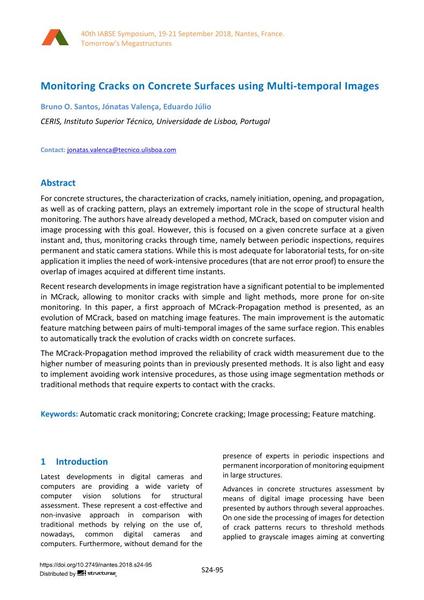Monitoring Cracks on Concrete Surfaces using Multi-temporal Images

|
|
|||||||||||
Détails bibliographiques
| Auteur(s): |
Bruno O. Santos
(CERIS, Instituto Superior Técnico, Universidade de Lisboa, Portugal)
Jónatas Valença Eduardo Júlio |
||||
|---|---|---|---|---|---|
| Médium: | papier de conférence | ||||
| Langue(s): | anglais | ||||
| Conférence: | IABSE Symposium: Tomorrow’s Megastructures, Nantes, France, 19-21 September 2018 | ||||
| Publié dans: | IABSE Symposium Nantes 2018 | ||||
|
|||||
| Page(s): | S24-95 | ||||
| Nombre total de pages (du PDF): | 8 | ||||
| DOI: | 10.2749/nantes.2018.s24-95 | ||||
| Abstrait: |
For concrete structures, the characterization of cracks, namely initiation, opening, and propagation, as well as of cracking pattern, plays an extremely important role in the scope of structural health monitoring. The authors have already developed a method, MCrack, based on computer vision and image processing with this goal. However, this is focused on a given concrete surface at a given instant and, thus, monitoring cracks through time, namely between periodic inspections, requires permanent and static camera stations. While this is most adequate for laboratorial tests, for on-site application it implies the need of work-intensive procedures (that are not error proof) to ensure the overlap of images acquired at different time instants. Recent research developments in image registration have a significant potential to be implemented in MCrack, allowing to monitor cracks with simple and light methods, more prone for on-site monitoring. In this paper, a first approach of MCrack-Propagation method is presented, as an evolution of MCrack, based on matching image features. The main improvement is the automatic feature matching between pairs of multi-temporal images of the same surface region. This enables to automatically track the evolution of cracks width on concrete surfaces. The MCrack-Propagation method improved the reliability of crack width measurement due to the higher number of measuring points than in previously presented methods. It is also light and easy to implement avoiding work intensive procedures, as those using image segmentation methods or traditional methods that require experts to contact with the cracks. |
||||
